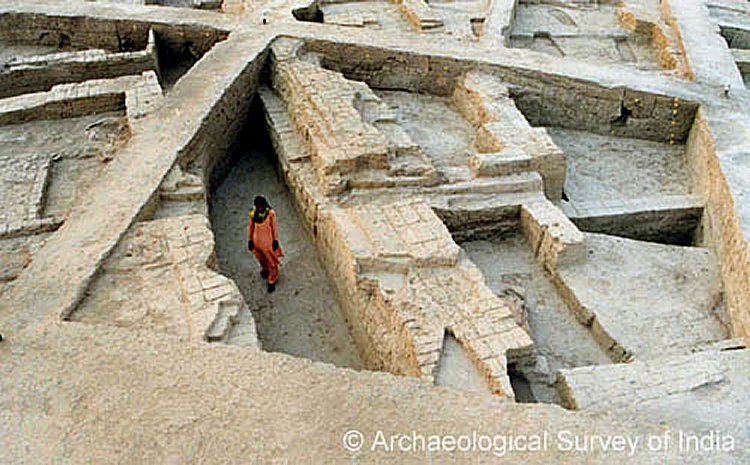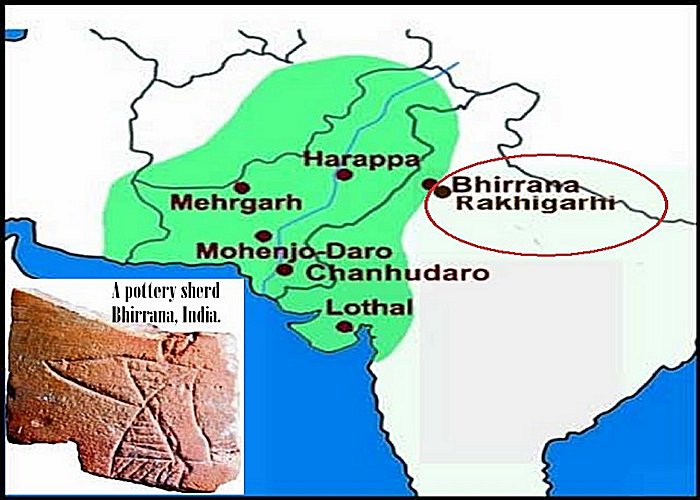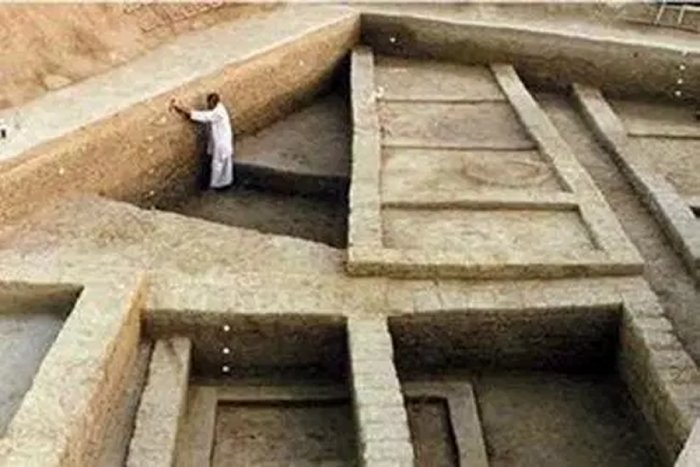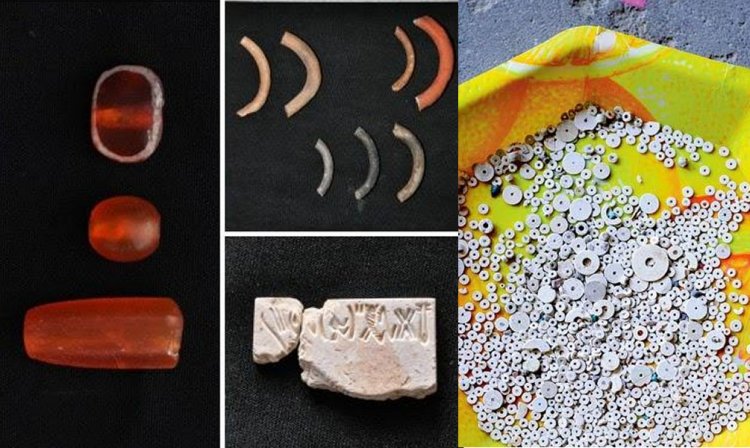Early Harappan Cultures Can Solve Mysteries Of Several Lost Cities Of Indus Valley Civilization
A. Sutherland - AncientPages.com - Studies strongly suggest that Indian Civilization emerged in the 8th millennium BC and pre-Harappan cultures, which were thoroughly studied, should be rather called as Early Harappan.
Asia's largest and oldest metropolis with gateways, built-up areas, streets and wells was built in Haryana, a state in North India with its capital at Chandigarh.
Artifacts from excavations in Bhirrana and Rakhigarhi.
While the carbon 14 dating of the excavations at the Mehrgarh site in Pakistan puts it in the 6400-7000 BC bracket, the latest study has revealed that the cultural remains at the Bhirrana village located on the banks of Ghaggar river, in Fatehabad district, in the state of Haryana, go back to the time bracket of 7300 BC.
Bhirrana, a Harappan town. Bhirrana was occupied from the earliest to the last dates of the Harappan era and Rakhigarhi in Haryana is home to the largest and one of the oldest sites of the ancient Indus Valley Civilization.
Bhirrana was occupied from the earliest to the last dates of the Harappan era. The earliest period, of the Hakra Ware culture, consisted of subterranean circular pit dwellings cut into the natural soil. These pit dwellings are noticed to the north of the Harappan town and below the Early Harappan structures of the town.
The cultural remains consist of pottery repertoire of different kinds, antiquities of copper, faience, steatite, shell, semi-precious stones like agate, carnelian, chalcedony, jasper, lapis lazuli, and terracotta.
The cultural remains consist of different kinds of terracotta, copper, faience, lapis lazuli, shell, semi-precious stones like agate, carnelian, chalcedony, and jasper.
Situated on the banks of Ghaggar river, in Fatehabad district, Bhirrana village date back to 7570-6200 BC.
Also Rakhigarhi - one of the five known biggest townships of Harappan civilization on the Indian sub-continent - is very old and shows continuous occupation from the 8th millennium BC.
It is located in Hisar district, Haryana and is home to the largest and one of the oldest sites of the ancient Indus Valley Civilization. Excavations conducted in the area of Rakhigarhi, showed that it was bigger in size than the Mohenjedaro and Harappa sites in Pakistan.
Rakhigarhi is the site for a large city that’s spread across 350-hectare of land, making it the largest Indus Valley city discovered yet.
Five interconnected mounds - of which two were thickly populated - spread in a huge area form the Rakhigarhi’s unique site.
The archaeological works revealed evidence of paved roads, drainage system, large rainwater collection, storage system, terracotta brick, statue production, a seal and a potsherd, both inscribed with the Harappan script; potsherds painted with concentric circles, fish-net designs, wavy patterns, floral designs and geometric designs.
The excavation in mound four has yielded a cornucopia of artifacts, including a seal and a potsherd, both inscribed with the Harappan script; potsherds painted with concentric circles, fish-net designs, wavy patterns, floral designs and geometric designs.
There were also found terracotta animal figurines, cakes, hopscotches, toy cart frame and wheel of terracotta, beads of semiprecious stones, terracotta, shell and copper objects and shell bangles.
Additionally, skilled metal working - in both bronze and precious metals - has also been uncovered. People lived in mud-brick as well as burnt-brick houses with a proper drainage system.
See also:
Ranikot Fort: Gigantic Great Wall Of Pakistan Shows Greatness Of Indus Valley Civilization
Indus Valley Civilization Far Ahead Of Its Time Has Baffled Scientists For Centuries
Curious Ancient Copper Plates And The Mystery Of Indus Valley
However, one of the most important discoveries is the discovery of a cemetery. The skeletons retrieved from the eight graves of the cemetery have been sent for DNA analysis. The most impressive grave was that of a woman, who was buried along with her child. She was wearing bangles and a precious necklace. Her grave had a vessel with food and all the necessary items that she could carry to the next world.
These skeletons may help us solve the mystery of why this civilization, which was flourishing at one point, seized to exist. Was it a climate change, the floods or was it perhaps a drought? Or did they just leave their houses and moved to some other place?
Perhaps not Bhirrana but Rakhigarhi's ancient remains have the potential to help us solve the mysteries of several lost cities of the great Indus Valley Civilization.
First version of this article was originally published on November 10, 2015
Written by – A. Sutherland - AncientPages.com Senior Staff Writer
Copyright © AncientPages.com All rights reserved. This material may not be published, broadcast, rewritten or redistributed in whole or part without the express written permission of AncientPages.com
Expand for referencesMore From Ancient Pages
-
 Ice Age Mystery – Unexplained Disappearance Of North America’s Large Mammals – New Clues
Fossils | Jun 1, 2024
Ice Age Mystery – Unexplained Disappearance Of North America’s Large Mammals – New Clues
Fossils | Jun 1, 2024 -
 Amazing Discovery: Great Pyramid Of Giza And Its Chambers Concentrate Electromagnetic Energy
Archaeology | Jul 31, 2018
Amazing Discovery: Great Pyramid Of Giza And Its Chambers Concentrate Electromagnetic Energy
Archaeology | Jul 31, 2018 -
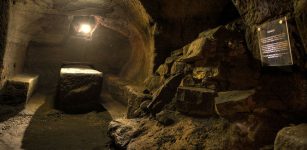 Gilmerton Cove: Mysterious Cave System Still Keeps Its Centuries-Old Secrets
Featured Stories | Nov 27, 2021
Gilmerton Cove: Mysterious Cave System Still Keeps Its Centuries-Old Secrets
Featured Stories | Nov 27, 2021 -
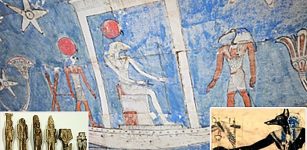 Ptolemaic Period’s Mummies With Nails And Tongues Of Gold Among Unique Remains Unearthed At Ancient City Of Oxyrhynchus, Egypt
Archaeology | Dec 19, 2024
Ptolemaic Period’s Mummies With Nails And Tongues Of Gold Among Unique Remains Unearthed At Ancient City Of Oxyrhynchus, Egypt
Archaeology | Dec 19, 2024 -
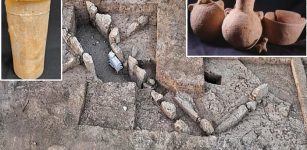 Ancient 5,500-Year-Old Gate Was Discovered Recently At Tell Erani, Near The Kiryat Gat Industrial Zone, Israel
Archaeology | Aug 17, 2023
Ancient 5,500-Year-Old Gate Was Discovered Recently At Tell Erani, Near The Kiryat Gat Industrial Zone, Israel
Archaeology | Aug 17, 2023 -
 Zoroaster’s Doomsday Prophecy About Comet Gochihr And Its Similarity With The Apocalypse Of John In The Book Of Revelation
Biblical Mysteries | Aug 17, 2017
Zoroaster’s Doomsday Prophecy About Comet Gochihr And Its Similarity With The Apocalypse Of John In The Book Of Revelation
Biblical Mysteries | Aug 17, 2017 -
 How Neanderthal Language Differed From Modern Human – They Probably Didn’t Use Metaphors
Human Beginnings | May 21, 2024
How Neanderthal Language Differed From Modern Human – They Probably Didn’t Use Metaphors
Human Beginnings | May 21, 2024 -
 Why Did Winter Baths Become So Popular?
Ancient History Facts | Jan 16, 2024
Why Did Winter Baths Become So Popular?
Ancient History Facts | Jan 16, 2024 -
 Ancient DNA Reveals Missing Link In The History Of Indo-European Languages
Linguistic Discoveries | Feb 5, 2025
Ancient DNA Reveals Missing Link In The History Of Indo-European Languages
Linguistic Discoveries | Feb 5, 2025 -
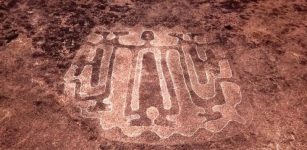 Intriguing Petroglyphs Reveal Traces Of A Lost Ancient Civilization In India
Archaeology | Oct 4, 2018
Intriguing Petroglyphs Reveal Traces Of A Lost Ancient Civilization In India
Archaeology | Oct 4, 2018 -
 Centeotl: Lord Of Maize Who Was Revered Before The Olmecs By All Mesoamerica’s Inhabitants
Featured Stories | Feb 20, 2024
Centeotl: Lord Of Maize Who Was Revered Before The Olmecs By All Mesoamerica’s Inhabitants
Featured Stories | Feb 20, 2024 -
 Bronze Age Royal Tombs Unearthed In Ruins Of Ancient City Of Pylos, Greece
Archaeology | Dec 30, 2019
Bronze Age Royal Tombs Unearthed In Ruins Of Ancient City Of Pylos, Greece
Archaeology | Dec 30, 2019 -
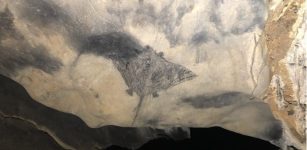 New Dating Of Intriguing Cave Art Reveals History Of Puerto Rican People
Archaeology | Oct 19, 2023
New Dating Of Intriguing Cave Art Reveals History Of Puerto Rican People
Archaeology | Oct 19, 2023 -
 Vikings’ Legacy Is Still Alive In Ireland – DNA, Ancient Ruins And Modern Cites Reveal
Civilizations | May 22, 2021
Vikings’ Legacy Is Still Alive In Ireland – DNA, Ancient Ruins And Modern Cites Reveal
Civilizations | May 22, 2021 -
 On This Day In History: He Wanted The Bible To Be Available To All – Burned At The Stake On Oct 6, 1536
News | Oct 6, 2016
On This Day In History: He Wanted The Bible To Be Available To All – Burned At The Stake On Oct 6, 1536
News | Oct 6, 2016 -
 What Was The Medieval Shame Flute?
Ancient History Facts | Jan 27, 2020
What Was The Medieval Shame Flute?
Ancient History Facts | Jan 27, 2020 -
 5 Traces Of Ancient Ancestors That Still Exist In All Human Bodies Today
Featured Stories | Jan 23, 2023
5 Traces Of Ancient Ancestors That Still Exist In All Human Bodies Today
Featured Stories | Jan 23, 2023 -
 King Henry VIII’s Walking Staff And Other Unusual Weapons
Artifacts | Nov 1, 2017
King Henry VIII’s Walking Staff And Other Unusual Weapons
Artifacts | Nov 1, 2017 -
 Legendary Brahan Seer Of The Clan Mackenzie (Coinneach) – The Scottish Nostradamus
Featured Stories | Jan 21, 2025
Legendary Brahan Seer Of The Clan Mackenzie (Coinneach) – The Scottish Nostradamus
Featured Stories | Jan 21, 2025 -
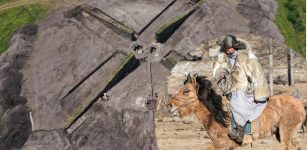 Ancient Burials Of World’s First Horse Riders Found Near The Black Sea
Archaeology | Mar 3, 2023
Ancient Burials Of World’s First Horse Riders Found Near The Black Sea
Archaeology | Mar 3, 2023


